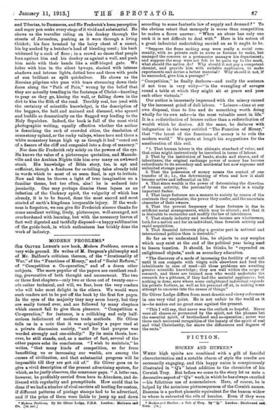THE .HOLY LAND.t
AnminERs of 77ze Other Side of the Lantern will not be dis- appointed. in Sir Frederick Treves's new volume. The journey described in it :begins at Jaffa and passes through Jerusalem, Bethlehem, Bethany, Jericho, The Dead Sea, Acre, Nazareth,
a (1) Delphitse de Sabran, Marquise de Onetime. Par Gaston Macgras et Le Comte Pierre de Crose-Lemereier. Paris : Plou-Neurrit et Cie. nr. 50c.] —(2) Memoirs of Dolphins de Sabran, Marais, da (Justine. From the French of Heaton Maugraa and the Comte P. de Croae.Lemereier. With frontispiece. London: W. Heinemann. [10s. net.]
The .Laad that is Decokes. By Sir Frederick Tram, Landea: Smith, 1334er and Vo. tea net.) and Tiberias, to Damascus, and Sir Frederick's keen perception and eager pen make every stage of it vivid and substantial. He shows us the traveller riding on his donkey through the streets of Jerusalem, pushing as it were through a living ?thicket; his face brushed by the hairy cheat of a camel, his leg soaked by a butcher's load of bleeding meat ; his hack 'whitened by a sack of flour ; in a crowd so dense that people lean against him and his donkey as against a wall, and push him aside with their bands like a stiff-hinged gate. We loiter with him in the silent byways, slashed with intense shadows and intense lights, dotted here and there with pools
-of sun brilliant as spilt quicksilver. He shows us the Russian pilgrims who pass with tears streaming down their Laces along the "Path of Pain," wrung by the belief that they are actually treading in the footsteps of Christ—kneeling to pray as- they go, kissing the wall, or falling down in the .dirt to kiss the filth of the road. Terribly real, too (real with the certainty of scientific knowledge), is the description of the beggars, the halt and Maimed and diseased, who sprawl and huddle so dramatically on the flagged way leading to the Holy Sepulchre. Indeed, the book is full of the most vivid photographic writing, equally effective whether the author is describing the reek of crowded cities, the desolation of some stony upland, or the rocky valleys, where here and there a white monastery hangs high up as though it had "oozed out of a fissure of the cliff and congealed into a drop of masonry." . Nor does Sir Frederick rely solely on the powers of the eye. Ile knows the value of a picturesque quotation, and Maunde and the Arabian Nights tide him over many an awkward strait. His knowledge of Bible story, too, is apt and -sufficient, though a fondness for re-telling tales already told in words which to most of us seem final, is apt to irritate. Now and then be throws a light of true imagination on a familiar theme, but too often, alas ! be is seduced into jocularity. One may perhaps dismiss these lapses as an infection of the Cockney spirit, the vulgarity of which has already, it is to be feared, done the most sacred and most storied of earth's kingdoms irreparable injury. If the weak- ness is forgotten, we can give Sir Frederick sincere thanks for some excellent writing, lively, picturesque, well-arranged, not overburdened with learning, but with the necessary leaven of fact well digested and tactfully disposed—a happy sublimation .of the guide-book, in Which enthusiasm has briskly done the stork of industry.











































 Previous page
Previous page